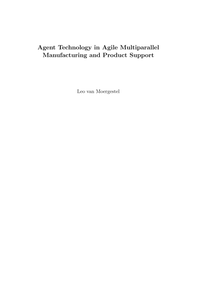This papers presents some ideas to use so-called software agents as a software representation of a product not only during manufacturing but also during the whole life cycle of the product. Software agents are autonomous entities capable of collecting useful information about products. By their design and capabilities software agents fit well in the concept of ubiquitous computing. We use these agents in our newly developed manufacturing process. This paper discusses further use of agent technology.
DOCUMENT

Dit proefschrift heeft als onderwerp de toepassing van agenttechnologie in productie en productondersteuning. Onder een agent verstaan we in deze context een autonoom opererende software entiteit die gemaakt is om een zeker doel te realiseren en daartoe met de omgeving comuniceert en zelfstandig acties kan uitvoeren. In moderne productiesystemen streeft men ernaar om de tijd van ontwerp tot productie zo kort mogelijk te houden en de productie af te stemmen op de wensen van de individuele eindgebruiker. Vooral dit laatste streven past niet in het concept van massaproductie. Een methode moet gezocht worden om kleine hoeveelheden of zelfs unieke producten tegen een lage kostprijs te fabriceren. Om dit te verwezenlijken zijn voor dit onderzoek speciale goedkope productieplatforms ontwikkeld. Deze hercongureerbare productiemachines noemen we equiplets. Een verzameling van deze equiplets in een gridopstelling geplaatst en gekoppeld met een snelle netwerkverbinding is in staat om een aantal verschillende producten tegelijk te produceren. Dit noemen we exibele parallelle productie. Voor de softwareinfrastructuur is agenttechnologie toegepast. Twee typen agenten spelen hierin een hoofdrol. Een productagent is verantwoordelijk voor de totstandkoming van een enkel product. De productiemachines worden voorgesteld door zogenoemde equipletagenten. De productagent weet wat er moet gebeuren voor het maken van een product terwijl de equipletagent weet hoe een of meer productiestappen moeten worden uitgevoerd. Het hier voorgesteld concept verschilt in veel opzichten van standaard massaproductie. Elk product in wording volgt zijn eigen, mogelijk unieke pad langs de equiplets, de productie wordt per product gescheduled en niet per batch en er is geen sprake van een productielijn. Dit proefschrift stelt de softwarearchitectuur voor en beschrijft oplossingen voor de routeplanning waarbij het aantal wisselingen tussen equiplets geminimaliseerd is, een scheduling die gebaseerd is op schedulingschema's zoals toegepast in real-time operating systems en een op autonome voertuigen gebaseerd transportsysteem. Bij al deze oplossingen speelt de productagent een belangrijke rol. (uit de samenvatting van het proefschrift) SIKS Dissertation Series No. 2014-31 The research reported in this thesis has been carried out under the auspices of SIKS, the Dutch Research School for Information and Knowledge Systems.
DOCUMENT

Technology in general, and assistive technology in particular, is considered to be a promising opportunity to address the challenges of an aging population. Nevertheless, in health care, technology is not as widely used as could be expected. In this chapter, an overview is given of theories and models that help to understand this phenomenon. First, the design of (assistive) technologies will be addressed and the importance of human-centered design in the development of new assistive devices will be discussed. Also theories and models are addressed about technology acceptance in general. Specific attention will be given to technology acceptance in healthcare professionals, and the implementation of technology within healthcare organizations. The chapter will be based on the state of the art of scientific literature and will be illustrated with examples from our research in daily practice considering the different perspectives of involved stakeholders.
LINK